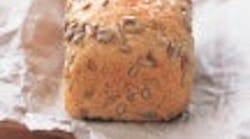Buy an expensive toy for your child and, typically, the kid ignores the gadget and plays with the box. Ever since fiber came into vogue in the 1970s and ‘80s, following Dennis Burkett's classic studies in South Africa, that's exactly how many consumers thought about high-fiber products: They'd enjoy the box more.
"Cardboard" was the common description of foods designed to fulfill the newly advocated fiber requirements. Fiber sounded good as a concept — a food component that may reduce cancer, heart disease, diabetes, and obesity — but in practice it was getting a bad image. Most Americans were not about to embrace foods from whole grains. This image is changing.
On February 14, 2011, the National Institutes of Health released results of the NIH-AARP diet and health study that for nine years followed 219,123 men and 168,999 women who were between 50 and 71 years old when the study began. The findings, which will appear in the June 14 issue of The Archives of Internal Medicine showed that people who consumed higher amounts of fiber, particularly from grains, had a significantly lower risk of dying compared to those who consumed lower amounts of fiber. The most significant health benefits in both men and women came from the use of whole grains and beans, although beans appeared to benefit men more than women.
Fiber absorbs water and slows movement of food through the small intestine, boosting satiety, trapping cholesterol and carbohydrates and slowing sugar absorption. This is why foods rich in fiber make you feel full longer and have positive effects on blood sugar, obesity and type 2 diabetes.
In the large intestine, fiber is converted into short-chain fatty acids and used for energy by colon cells. The term we've come to associate with soluble fiber is "prebiotic." And these prebiotics act as food for probiotics, the healthy bacteria that populate the colon.
The newest fiber in the food processing arena is not a fiber, it's resistant starch, so called because it resists normal digestion in the small intestines. Resistant starch ends up in the colon to be converted into short chain fatty acids and is thus classified as a (soluble) fiber. In the large intestine, fiber moves food through more quickly. A number of studies (though not all) associate this action with lowered risk of colon cancer.
The trick to getting fiber into the diet has always been getting people to eat it. Typically that required consumer commitment beyond flavor and organoleptic enjoyment. Today, all it takes is deception on the part of the food industry. Not deception as in fraud but more of a "parlor trick" made possible by advanced technology.
Stir fiber into liquid and you have a gooey, clumpy glop because of the way fiber absorbs water. In food formulations, fiber can be part of the matrix, although the absorption quality makes high-fiber foods dense. In beverages, however, fiber just makes a gummy mess. That's where the techno-trick comes in: Encapsulate the fiber molecules in protein and keep the fiber away from the liquid. Fiber can now go anywhere without palate detection.
After you swallow the fiber — in the form of a smoothie for example — digestive enzymes break down the protein capsule and release the fiber, which gains access to water. Fiber is now free to go on its merry way — at least some fiber, that is. There's a form of fiber that's insoluble, derived from the bran that coats grain. The bran is a dark, wood-like material that is very tough. While you can't make it invisible, you can use a different variety of wheat, one with a softer, lighter colored hull, and then grind it a little finer. The result is something we've come to know as "whole-grain white flour." That sounds like an oxymoron, but it's just another way to disguise fiber.
The obvious question is whether increasing fiber in one or more disguised methods — resistant starch, inulin, white whole wheat — will produce the same results as in traditional methods of increasing fiber when followed over a long period of time. As long as the applications are not only acceptable to the palate but nutrient-dense, the future of fiber looks positive.


